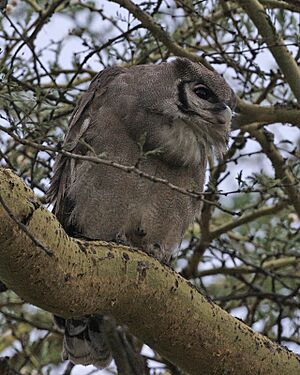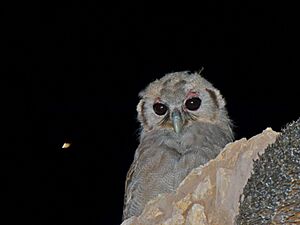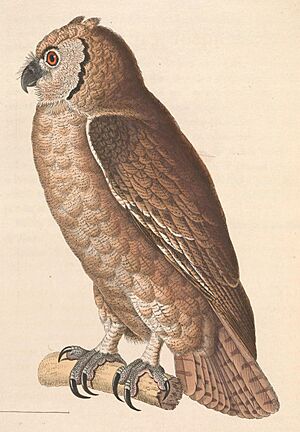Verreaux's eagle-owl facts for kids
Quick facts for kids Verreaux's eagle-owl |
|
|---|---|
 |
|
| From Etosha National Park | |
| Conservation status | |
| Scientific classification | |
| Genus: |
Ketupa
|
| Species: |
lactea
|
The Verreaux's eagle-owl (Ketupa lactea), also called the milky eagle owl or giant eagle owl, is a large owl found in sub-Saharan Africa. It belongs to the owl family Strigidae. This owl is the biggest in Africa, growing up to 66 cm (26 in) long.
Verreaux's eagle-owls mostly live in dry, wooded savanna areas. They are mostly grey with light brown markings. What makes them special are their bright pink eyelids, which no other owl in the world has!
These owls are powerful hunters with strong claws. They eat many different animals, mostly mammals. But they also hunt birds, insects, and anything else they can catch. The IUCN (International Union for Conservation of Nature) says this owl is of Least Concern. This means it's not currently in danger of disappearing. It lives in many places and can adapt to changes made by humans.
The owl is named after Jules Verreaux, a French naturalist. He collected the first owl specimen when he was a teenager.
Contents
About the Verreaux's Eagle-Owl
Verreaux's eagle-owls are very large and strong. They are the biggest owls in Africa and the largest owls found in warm, tropical areas. They are also one of the heaviest owls in the world.
These owls can be from 58 to 66 cm (23 to 26 in) long. Their wingspan can reach about 140 cm (4.6 ft). Female owls are usually bigger than males. A female can be about 35% heavier than a male. Males weigh around 1,700 g (3.7 lb), while females can weigh about 2,600 g (5.7 lb).
Their feathers are a pale grey with fine brownish lines on their belly. Their back is light brown with white spots on the shoulders. The face is lighter, sometimes whitish, with strong black borders. Their eyes are dark brown. Like other eagle-owls, they have ear-tufts, but these are smaller and can be hard to see.
The pink eyelids are a unique feature. Scientists aren't sure why they are pink. Some think they might be used during mating displays, like how other owls use their colorful eyes.
What Does it Sound Like?
The call of the Verreaux's eagle-owl is very deep, one of the deepest bird calls in the world. It sounds like a deep "gwok, gwok, gwonk-gwokwokwok." This sound is so deep that it can sometimes be mistaken for a leopard! On quiet nights, their call can travel up to 5 km (3 mi).
Female calls are similar but higher-pitched. Breeding pairs often call together. When they are alarmed, they make a deep "whok" or "hook" sound. Young owls make high, piercing calls when they are hungry.
Where Verreaux's Eagle-Owls Live
Verreaux's eagle-owls live across most of sub-Saharan Africa. They are not found in thick rainforests. You can find them most often in eastern and southern Africa.
They prefer savanna areas with scattered trees and thorny bushes. They also live in dry regions, sometimes near semi-desert areas. They can be found near riverside forests and small woodlands.
These owls can live at almost any height, from sea level up to about 3,000 m (9,800 ft) in mountains. However, they usually avoid very rocky or mountainous places. In southern Africa, the bushveld is a perfect home for them.
How Verreaux's Eagle-Owls Behave
Verreaux's eagle-owls are nocturnal, meaning they are active at night. During the day, they rest in trees. They like large, shady branches of tall, old trees. They sleep lightly and wake up quickly if they need to defend themselves.
Family groups, including parents and their young, often rest together. They might even preen each other's feathers. Sometimes, young owls stay with their parents for up to three years, which is very unusual for owls!
On very hot days, they may flutter their throats to cool down. They also drink water at night. Each pair of owls defends a large territory, which can be as big as 7,000 hectares (17,000 acres).
What Verreaux's Eagle-Owls Eat
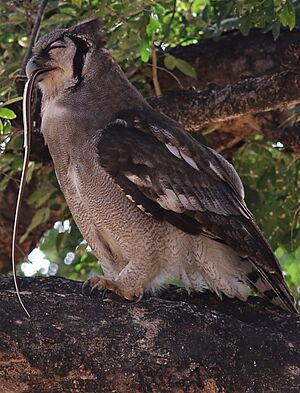
Verreaux's eagle-owls are considered "apex predators," meaning they are at the top of their food chain. Healthy adult owls usually don't have natural predators. They hunt mostly in the early evening.
They usually hunt by swooping down on their prey from a perch. They can also hunt while flying, even catching flying insects. Sometimes, they run after prey on the ground or wade into shallow water to catch fish.
These owls are very opportunistic hunters, meaning they will eat almost anything they can catch. Their diet is very varied. They eat over 100 different types of prey! Their prey can range from tiny insects weighing less than 5 g (0.18 oz) to large animals weighing at least 10 kg (22 lb). This is one of the widest ranges of prey sizes for any owl.
Mammals They Hunt

Hedgehogs are a common prey for Verreaux's eagle-owls. These owls are one of the only regular predators of hedgehogs in Africa. When they catch a hedgehog, they silently ambush it and grab its face with their talons. After killing it, they carefully remove the prickly skin before eating it. You can often find many hedgehog skins around their nests!
They also eat many other mammals. They hunt rodents like mole-rats and larger rats. They also catch bats, from very small ones to larger fruit bats. Hares, like the scrub hare, are also a significant part of their diet in some areas.
Verreaux's eagle-owls are one of the few owls that hunt different types of primates. They often prey on galagos (bushbabies), which are nocturnal primates. They also sometimes hunt monkeys like vervet monkeys. They can even take half-grown vervet monkeys, which are almost as heavy as the owl itself!
Sometimes, they eat very large animals like young warthogs or small antelopes called Kirk's dik-diks. They might also scavenge on animals that have already died, like roadkill.
They hunt small meat-eating mammals like mongooses and African striped weasels. They have even been known to attack small wild cats. At one place in Kenya, these owls regularly hunt outdoor domestic cats, making the cats very nervous!
Birds They Hunt
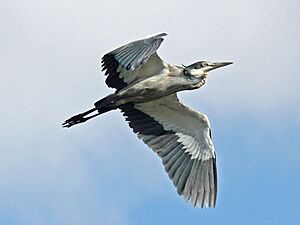
Verreaux's eagle-owls eat many different kinds of birds, over 50 species! They often take young birds from nests, but they also catch adult birds. In some areas, birds are even more important than mammals in their diet.
They hunt large water birds like black-headed herons and different types of ducks. They also eat ground-dwelling birds like helmeted guineafowls and francolins. Domestic birds like chickens are also hunted if they are sleeping out in the open.
Upland birds like rock pigeons and hornbills are also on their menu. They often hunt crows, which are a favorite prey for many large owls because they are big and easy to find at night. The smallest bird they are known to eat is the southern yellow white-eye. They can even hunt young ostriches and grey crowned cranes.
Other Prey
Verreaux's eagle-owls sometimes eat reptiles and amphibians. They hunt snakes, from small harmless ones to large, venomous Egyptian cobras. Frogs and toads are also part of their diet. The largest reptile they are known to eat is the Nile monitor, a large lizard.
They also eat a surprising number of invertebrates. This includes large ground beetles and dung beetles. They have even been seen diving under African buffalo to catch dung beetles! Tiny insects like termites, scorpions, and spiders have also been found in their diet.
Reproduction and Life Cycle
Verreaux's eagle-owls usually breed during the dry season. The male and female owls form a strong pair, often staying together for life. During courtship, they make excited calls, hoot, and whine. They bow to each other, open their wings, and preen each other's feathers.
These owls are very territorial. They defend their large territory with their calls.
Unlike most owls, Verreaux's eagle-owls usually don't build their own nests. They use old nests built by other large birds. They often use the big, sturdy stick nests of vultures, eagles, or crows. They especially like the unusual, massive nests of hamerkops, often nesting on top of them. If a nest is occupied, the eagle-owls will take it over, sometimes even eating the birds that built it!
The female owl usually lays two white eggs. The eggs are laid a few days apart. The female sits on the eggs for 33 to 39 days to keep them warm. When the chicks hatch, they are covered in white down.
Because the eggs hatch at different times, the first chick is always much bigger than the second. Sadly, the smaller chick often dies because it can't compete for food with its older sibling. It's rare for both chicks to survive.
The mother owl stays on the nest while the male hunts for food for both of them. After the chicks hatch, the mother continues to be fed by the male for about 20 days. Both parents bring food to a special "plucking" or "peeling" perch near the nest. Here, they tear the prey into smaller pieces for their young.
The mother owl is very protective of her nest. She might not even move if someone shouts at her! If intruders, like other owls or humans, come too close, the parents will grunt and clap their bills. They might also pretend to be injured to distract predators, flying low with drooping wings. This helps to lure danger away from their young. In one case, parents successfully lured away wild dogs from a fallen chick.
Young owls leave the nest when they are about 62-63 days old, but they can't fly well yet. It takes another two weeks to a month for them to become good fliers. After leaving the nest, they are very inactive and stay close by, begging their parents for food. They make a shrill noise and do a "hunger dance" by swaying and shifting their weight.
Young owls rely on their parents for food for a long time. They might even beg for food into the next breeding season! Sometimes, older siblings from previous years might even help bring food for the new chick.
Verreaux's eagle-owls become adults and can have their own young when they are about three to four years old. They usually nest every year, but sometimes they might skip a year if there isn't enough food. They live for over 15 years in captivity, and possibly up to 30 years.
Status and Conservation
Verreaux's eagle-owls are not seen very often because they live in low numbers and need large areas to hunt and breed. They face some threats, like many other large birds of prey.
Sometimes, people hunt them because they might eat small farm animals. However, this is rare, especially where there is plenty of wild prey. Pesticides can also harm them if they eat poisoned prey. They can also be hurt by flying into power lines or dams.
Losing their habitat is another problem, as they need large trees with big nests. However, these owls can adapt. They have been seen nesting in areas near towns and cities, which shows they can live alongside humans better than some other large birds.
In some areas, like Eswatini (formerly Swaziland), they are considered "Near Threatened." But overall, the Verreaux's eagle-owl is widespread and not currently in danger of extinction.
Images for kids





